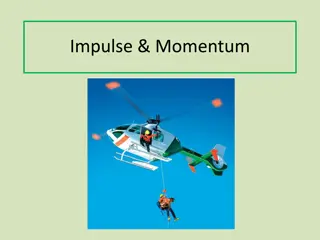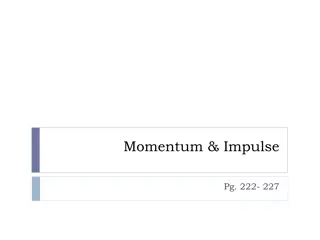Understanding Momentum in Physics
Momentum, first introduced by Isaac Newton, is symbolized by the letter p and signifies inertia in motion. It is calculated as mass multiplied by velocity (p = m * v) and has the unit of kg * m/s. The amount of momentum depends on the object's mass and speed. A moving object has more momentum if either its mass or speed is large, while an object at rest has zero momentum. When velocity changes, momentum also changes, leading to acceleration and the presence of a net force. Impulse, defined as the change in momentum, is a crucial concept in physics, emphasizing the relationship between force and time. By exerting impulses, one can alter the momentum of an object. Strategies for changing momentum include increasing force or extending the time of contact to enhance momentum or dissipate it over a longer period. An exploration of momentum can be further facilitated through scenarios like the comparison of momentum between a truck and a roller skate moving downhill.
Download Presentation

Please find below an Image/Link to download the presentation.
The content on the website is provided AS IS for your information and personal use only. It may not be sold, licensed, or shared on other websites without obtaining consent from the author. Download presentation by click this link. If you encounter any issues during the download, it is possible that the publisher has removed the file from their server.
E N D
Presentation Transcript
It was first introduced by Isaac Newton. Momentum is symbolized by the letter p It means inertia in motion.
Momentum = mass * velocity (Velocity has direction, therefore momentum is a vector) p = m * v Unit of p = kg * m/s
Therefore, the amount of momentum is based on the amount of mass of the object and its speed.
A moving object has larger momentum if 1. mass is large or 2. speed is large At rest, an object has No (zero) momentum. Why?
Question Which has more momentum: a truck moving downhill or a roller skate moving down hill at the same speed? Will the trucker always have more momentum than the roller skate? Can the truck and the roller skate ever have the same momentum?
Therefore, if velocity changes, so does the momentum and the body will be accelerated, therefore a net force is present.
Impulse Impulse = change in momentum I = mv I = F * t Unit = (kg*m/s2) * s N * s Therefore Ft=mv
--longer time a force is exerted on something the more change in momentum (greater the impulse) --If you wish to change the momentum of an object, exert an impulse on it. To do this, force and time are important. There are several ways to change the momentum of an object.
Case 1 Increase Momentum by ~Increasing the force on an object ~(or) extend the time of contact Ex: hitting a baseball swing hard & follow through
Case 2 -- Decrease Momentum over a long time by Ex: in your car would you rather hit a concrete wall or a haystack? (haystack because it extends the time of contact ) ~if longer time, yields a smaller force
Ex: padded dashboards, airbags, catch ball by moving arm backward with the ball, jumping to the ground by bending knees, falling on wooden floor vs. concrete
QuestionIf the boxer is able to make the duration of the impact five times as long by riding with the punch, by how much will the impact be reduced? --The force of impact will be 5 times less than if you didn t pull back.
Case 3 Decreasing Momentum Over a short time by ~If the time is short Force of impact is large Ex. Car hits wall
Ex. Karate chop breaks bricks (Bounce makes force even greater!)
Bouncing Impulses are greater when bouncing takes place because you need an impulse to bring the object to a stop as well as to send it back in the opposite direction. Question? Which would hurt more if a flower pot fell on your head, or if it hit and bounced back? Ans: Hit and bounced back
Examples: If the mass of an object is 8kg and its velocity is 1.4 m/s, what is its momentum? What is the velocity of an object whose mass is 3.2 kg and momentum is 2.41 N*s? What is the mass of an object whose momentum is 8.21 N*s and whose velocity is 4.4 m/s?
What is the impulse on an object when the force exerted is -22 N and is exerted over a time of 31.1 seconds? If the impulse on an object is 85 N*s, and the force exerted on it is 14 N, how long was the force exerted on the object? What is the force exerted on an object is the impulse on it is 42 N*s and the force is exerted over a time of 53 seconds?























